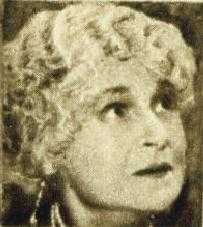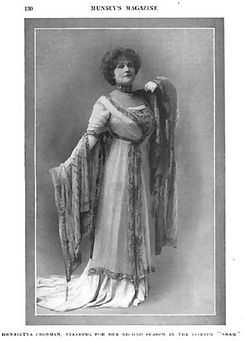Henrietta Crosman
| Henrietta Crosman | |
|---|---|
 | |
| Born |
Henrietta Crosman September 2, 1861 Wheeling, West Virginia |
| Died |
October 31, 1944 (aged 83) Pelham Manor, New York |
| Occupation | Actress |
| Years active | 1883-1940s |
| Spouse(s) |
J. Sedley Browne Maurice Campbell |
| Children |
George Browne Maurice Campbell Jr. |
Henrietta Crosman (September 2, 1861 – October 31, 1944) was an American stage and film actress. She was born in Wheeling West Virginia to George Crosman, a Civil War Major and Mary B. Wick, who was a niece of Stephen Foster.[1][2]
Theatrical career
Crosman moved all over the US from post to post with her army father, and so was educated in many places. On leaving school she decided to become an actress. She got her start in 1883 at the old Windsor Theatre, New York with the assistance of the long-time theatre manager John A. Ellsler. Crosman debut role was the character Lilly in Bartley Campbell's The White Slave.[3][4] Then she toured the country with Robert L. Downing in classic parts. In 1889 she appeared in her first Shakespeare play As You Like It at Daly's theater. During the course of the early 1890s she was managed by Daniel Frohman and appeared in his stock company. From 1892-94 her career was managed by Daniel's brother, Charles Frohman. For a short period during 1891, and in between Frohman brothers, she was under the aegis of A. M. Palmer.

The types of roles Crosman excelled in were adventure romances or the popular drawing farces then prevalent in the late Victorian era. By 1900 Crosman was a star and appeared for the first time as such in Mistress Nell keeping in line with the sort of costume adventures that were becoming her forte. In 1902, she appeared in the productions of "Joan of the Shoals", "As You Like It" and "The Sword of the King". In 1903, she premiered another exceptional play "Sweet Kitty Bellairs". Several of these plays would turn up as films in the silent era played by younger actresses. In 1911, Crosman and her company staged 60 performances of Catherine Chisholm Cushing's comedy "The Real Thing" at the Maxine Elliott Theatre in New York,[5] before taking the show on the road. In early July 1912, Crosman and company were in Regina, Saskatchewan, Canada following the Regina Cyclone, and staged a benefit performance of "The Real Thing" for the victims.[6] Now in her forties, Crosman was starting to move away from the strenuous sword carrying, heavy costume adventures that she was popular in. Much of the remainder of her theatrical career would consist of drawing room comedies and farces, a type of playing that was less hectic for an ageing actress. However she would return to revivals of Shakespeare i.e. The Merry Wives of Windsor in 1915 with Viola Allen or in the 20s Sheridan's The Rivals.[7]
Movies
Crosman, like many a heralded stage star, held off from motion pictures. But by 1914 and possibly out of curiosity she 'signed up', as the popular motto went at the time, for a one picture deal with Adolph Zukor's Famous Players. The film was a movie version of The Unwelcome Mrs. Hatch,[8] which as a play had been a winning success for Mrs Fiske in 1901 on Broadway. The Supreme Test followed in 1915 for Universal but afterwards her silent film appearances were sporadic. Her husband Maurice Campbell joined his wife in the movie industry eventually becoming a noted director. By 1930 silent films had given way to talking pictures and as in 1914 the motion picture business courted stage trained actors. Crosman a veteran and now approaching seventy had a career resurgence endearing herself to a new younger generation who never had the chance to see her in her youth on stage. One of her first talking movies was The Royal Family, a Paramount version of the play by Edna Ferber, loosely based on the Barrymore family
Personal life
Despite her very busy theater career Crosman found time to marry and gave birth to two sons. George was born in 1887 with her first husband J. Sedley Brown. Brown later married actress Carrie Clark Ward. By the mid-1890s she was married to Maurice Campbell and bore him a son, Maurice Jr. in 1896. Campbell was a Broadway stage director and producer. He and Crosman joined the nascent silent film industry and he was for a time in the 1920s a noted film director. The marriage to Campbell, eight years her junior, was a long and happy one and ended with his death in 1942.[9] Crosman survived her husband by two years passing away in October 1944.
Filmography
- The Unwelcome Mrs. Hatch (1914)
- The Supreme Test (1915)
- How Molly Made Good (1915 (*herself; cameo appearance)
- Broadway Broke (1923)
- Wandering Fires (1925)
- The Royal Family of Broadway (1930)
- Pilgrimage (1933)
- Carolina (1934)
- Three on a Honeymoon (1934)
- Such Women Are Dangerous (1934)
- Among the Missing (1934)
- The Curtain Falls (1934)
- Elinor Norton (1934)
- Menace (1934)
- The Right to Live (1935)
- The Dark Angel (1935)
- Charlie Chan's Secret (1936)
- Hitch Hike to Heaven (1936)
- The Moon's Our Home (1936)
- Girl of the Ozarks (1936)
- Follow Your Heart (1936)
- Personal Property (1937)
References
- ↑ Henrietta Crosman - North American Theatre Online
- ↑ GREAT STARS OF THE AMERICAN STAGE by Daniel Blum c. 1952 Profile #15
- ↑ The Burr McIntosh Monthly 1905 accessed 5.25.13
- ↑ The Players Blue Book, 1901, p.86 accessed 5.25.13
- ↑ http://www.imdb.com/name/nm0189093/otherworks
- ↑ http://www.morethanamonster.com/downloads/Karloff-in-Saskatchewan.pdf
- ↑ WHO WAS WHO IN THE THEATRE: 1912-1976, originally by John Parker, culled from many of his editions published annually (Crosman, Henrietta; page 564)
- ↑ PICTORIAL HISTORY OF THE SILENT FILM by Daniel Blum c.1953 page54
- ↑ Internet Movie Database: Maurice Campbell 1869-1942
External links
| Wikimedia Commons has media related to Henrietta Crosman. |
- Henrietta Crosman at the Internet Movie Database
- Henrietta Crosman IBDb.com
- Henrietta Crosman gravesite Findagrave.com
- Henrietta Crosman gallery at the NY Public Library
- Henrietta Crosman 1892 portrait Univ of Louisville Macauley Theater Collection
- Henrietta Crosman picture gallery Univ of Washington Sayre collection
- Henrietta Crosman; PeriodPaper.com c.1910
|